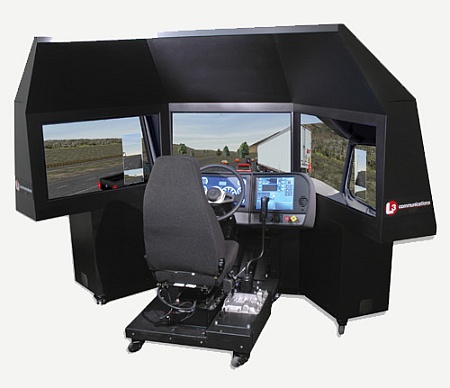ATRI report explores effectiveness of simulator training
A new research white paper released by the American Transportation Research Institute (ATRI) suggests that drivers who received targeted simulator training had fewer safety incidents over time, but those effects dissipated after one year.
The report, Safety Impacts of Truck Driver Simulator Training, investigated the effectiveness of using customized truck driving simulators to target specific driving behaviors that have been associated with increased crash risk.
The study incorporated driving behaviors previously identified in ATRI’s Predicting Truck Crash Involvement report. The study developed a series of “targeted” training scenarios for use in driving simulators. ATRI then partnered with motor carriers to collect driver safety and training data for drivers trained on both general and ATRI-customized scenarios. Finally, the safety performance differences between drivers were analyzed at six and 12-month post-training milestones based on the type of simulator training received.
The initial results at the six-month mark suggested that drivers who received the targeted simulator training had fewer safety incidents over time, but those effects dissipated at the 12-month mark. While driver turnover may play a role in the declining significance, the white paper suggests that carriers examine the frequency of sustainment training for drivers.
Truck driving simulators provide carriers with the ability to offer a wide variety of training exercises to drivers from the safety and convenience of a classroom. By focusing training efforts on correcting behaviors that have a known correlation to crash risk, carriers can take a proactive step towards preventing future crashes.
The ATRI study follows a 2011 report by the Federal Motor Carrier Safety Administration (FMCSA) that looked at entry-level training of commercial motor vehicle drivers and a FMCSA Truck Simulator Validation study that sought to determine if simulator technology enhances real-world tractor-trailer driver training and safety performance.
FMCSA’s 2011 report examined the effectiveness of simulation training by comparing the research results of four different types of entry-level CMV driver training:
- Conventional Training: Conventional entry-level training occurs in both classroom and BTW settings. Students receive instruction on concepts, techniques, and fleet safety. In addition to the classroom, students practice range driving (for skills maneuvers) and road driving (which includes learning proper shifting, making turns, and responding to situations while driving actual trucks on the road under the supervision of trainers). In order to obtain PTDI certification, these courses must include a minimum of 104 hours of classroom time and 44 hours of BTW training per student. It should be noted that some carriers offer PTDI-certified conventional training; however, no entry-level drivers in the present study were trained in their courses.
- Simulator Training: Simulator training is similar to conventional entry-level training in that both a classroom and a BTW component is present. However, with simulator training, a portion of the BTW training occurs in a driving simulator. For the present study, students received approximately 60 percent of their BTW training in a simulator.
- Informal Training: Informal training occurs when a driver receives training in an informal or non-structured setting. No requirements for classroom or BTW time are present and the trainer may not necessarily be certified. A friend or family member may provide informal training.
Analysis of the DMV road test scores found that simulator-based training of entry-level drivers appears to be feasible.
The simulator used in the study was a tractor-trailer simulator that used computer-generated imagery on five 60-inch screens through projectors surrounding a generic truck cab to provide a seamless 225 degree forward field of view. Actual flat mirrors reflect images from plasma monitors mounted behind the cab in order to provide parallax for the driver.
The cab has original equipment manufacturer working gauges, indicator and warning lights, pedals, and shifter with range selector. The seat provides heave, pitch, and roll based on environmental conditions and driver inputs to the vehicle controls. Force feedback steering is used to provide tactile feedback for different road surfaces, resistance at different road speeds, and curb strikes. Tractor and trailer characteristics and dynamics, along with the driving environment, can be manipulated to create specific, customized scenarios.
A library of automobiles, trucks, buses, pedestrians, signs, buildings, and other objects is available to further enhance scenarios. In addition, the simulator provides the ability to give overhead views and instantly halt the driving scenario, as well as replay or re-drive the prior 30 seconds of the scenario.






